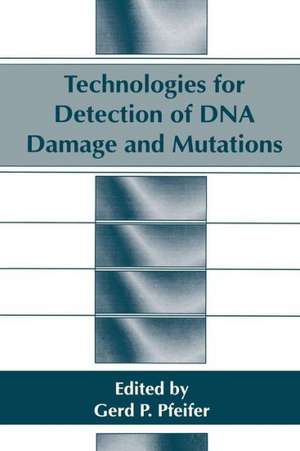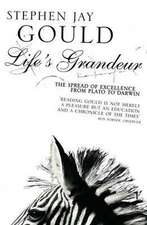Technologies for Detection of DNA Damage and Mutations
Editat de G.P. Pfeiferen Limba Engleză Paperback – 18 iun 2013
| Toate formatele și edițiile | Preț | Express |
|---|---|---|
| Paperback (1) | 947.17 lei 6-8 săpt. | |
| Springer Us – 18 iun 2013 | 947.17 lei 6-8 săpt. | |
| Hardback (1) | 966.15 lei 6-8 săpt. | |
| Springer Us – 30 iul 1996 | 966.15 lei 6-8 săpt. |
Preț: 947.17 lei
Preț vechi: 1155.09 lei
-18% Nou
Puncte Express: 1421
Preț estimativ în valută:
181.24€ • 189.71$ • 150.85£
181.24€ • 189.71$ • 150.85£
Carte tipărită la comandă
Livrare economică 31 martie-14 aprilie
Preluare comenzi: 021 569.72.76
Specificații
ISBN-13: 9781489903037
ISBN-10: 1489903038
Pagini: 468
Ilustrații: XXVI, 441 p.
Dimensiuni: 155 x 235 x 25 mm
Greutate: 0.65 kg
Ediția:Softcover reprint of the original 1st ed. 1996
Editura: Springer Us
Colecția Springer
Locul publicării:New York, NY, United States
ISBN-10: 1489903038
Pagini: 468
Ilustrații: XXVI, 441 p.
Dimensiuni: 155 x 235 x 25 mm
Greutate: 0.65 kg
Ediția:Softcover reprint of the original 1st ed. 1996
Editura: Springer Us
Colecția Springer
Locul publicării:New York, NY, United States
Public țintă
ResearchDescriere
Man-made carcinogens, natural genotoxic agents in the environment, as well as ionizing and ultraviolet radiation can damage DNA and are a constant threat to genome integrity. Throughout the evolution oflife, complex DNA repair systems have developed in all living organisms to cope with this damage. Unrepaired DNA lesions can promote genetic alterations (mutations) that may be linked to an altered phenotype, and, if growth-controlling genes are involved, these mutations can lead to cell transformation and the development of malignant tumors. Proto oncogenes and tumor suppressor genes may be critical targets for DNA damaging agents. In a number of animal model systems, correlations between exposure to a carcinogen, tumor develop ment, and genetic changes in tumor DNA have been established. To understand mutagenesis processes in more detail at the molecular level, we need to know the type and frequency of DNA adducts within cells, their distribution along genes and specific DNA sequences, as well as the rates at which they are repaired. We also need to know what types of mutations are produced and which gene positions are most prone to mutagenesis. This book provides a collection of techniques that are useful in mutagenesis research. The book is divided into three parts. In Part I, methods for DNA damage and repair analysis are provided.
Cuprins
Technologies for Detection of DNA Damage: Microgel Electrophoresis of DNA from Individual Cells: Principles and Methodology (N.P. Singh). The Cytokinesisblock Micronucleus Technique (M. Fenech). Agarose Gel Electrophoresis for DNA Damage Analysis (R. Drouin et al.). 32ppostlabelling for Detection of DNA Adducts (R.C. Gupta). A Postlabelling Assay for Oxidative Damage (M. Weinfeld et al.). Technologies for Detection of Mutations: Heteroduplex Analysis (D. Glavac, M. Dean). Mutation Analysis by Denaturing Gradient Gel Electrophoresis (DGGE) (R. Fodde, M. Losekoot). Single Strand Conformation Polymorphism Analysis (T. Sekiya). Twodimensional Gene Scanning (D. Li, J. Vijg). Ligase Chain Reaction for the Detection of Specific DNA Sequences and Point Mutations (R.B. Wallace et al.). Mammalian Systems for Mutation Analysis: Detection and Characterization of Mutations in Mammalian Cells with the pSP189 Shuttle Vector System (M.M. Seidman). The HPRT Gene as a Model System for Mutation Analysis (V.M. Maher, J.J. McCormick). Bacteriophage Lambda and Plasmid lacZ Transgenic Mice for Studying Mutions in vivo (J. Vijg, G.R. Douglas). The Use of lacI Transgenic Mice in Genetic Toxicology (J.G. de Boer et al.). Genotypic Mutation Assay (RFLP/PCR) (F. Aguilar, P. Cerutti). 16 additional articles. Index.















